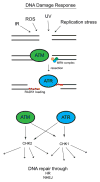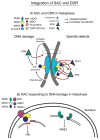The spindle assembly checkpoint: More than just keeping track of the spindle
- PMID: 27667906
- PMCID: PMC5033511
The spindle assembly checkpoint: More than just keeping track of the spindle
Abstract
Genome stability is essential for cell proliferation and survival. Consequently, genome integrity is monitored by two major checkpoints, the DNA damage response (DDR) and the spindle assembly checkpoint (SAC). The DDR monitors DNA lesions in G1, S, and G2 stages of the cell cycle and the SAC ensures proper chromosome segregation in M phase. There have been extensive studies characterizing the roles of these checkpoints in response to the processes for which they are named; however, emerging evidence suggests significant crosstalk between the checkpoints. Here we review recent findings demonstrating overlapping roles for the SAC and DDR in metaphase, and in response to DNA damage throughout the cell cycle.
Keywords: DNA damage; cell cycle; checkpoint; chromosome segregation; spindle assembly.
Conflict of interest statement
STATEMENT No conflict of interests.
Figures



Similar articles
-
DNA damage response and spindle assembly checkpoint function throughout the cell cycle to ensure genomic integrity.PLoS Genet. 2015 Apr 21;11(4):e1005150. doi: 10.1371/journal.pgen.1005150. eCollection 2015 Apr. PLoS Genet. 2015. PMID: 25898113 Free PMC article.
-
Mitotic and DNA Damage Response Proteins: Maintaining the Genome Stability and Working for the Common Good.Front Cell Dev Biol. 2021 Dec 13;9:700162. doi: 10.3389/fcell.2021.700162. eCollection 2021. Front Cell Dev Biol. 2021. PMID: 34966733 Free PMC article. Review.
-
A role for the spindle assembly checkpoint in the DNA damage response.Curr Genet. 2017 May;63(2):275-280. doi: 10.1007/s00294-016-0634-y. Epub 2016 Aug 3. Curr Genet. 2017. PMID: 27488803 Free PMC article.
-
Recent Progress on the Localization of the Spindle Assembly Checkpoint Machinery to Kinetochores.Cells. 2019 Mar 23;8(3):278. doi: 10.3390/cells8030278. Cells. 2019. PMID: 30909555 Free PMC article. Review.
-
Arabidopsis Cell Division Cycle 20.1 Is Required for Normal Meiotic Spindle Assembly and Chromosome Segregation.Plant Cell. 2015 Dec;27(12):3367-82. doi: 10.1105/tpc.15.00834. Epub 2015 Dec 15. Plant Cell. 2015. PMID: 26672070 Free PMC article.
Cited by
-
Seize the engine: Emerging cell cycle targets in breast cancer.Clin Transl Med. 2024 Jan;14(1):e1544. doi: 10.1002/ctm2.1544. Clin Transl Med. 2024. PMID: 38264947 Free PMC article. Review.
-
DNase II mediates a parthanatos-like developmental cell death pathway in Drosophila primordial germ cells.Nat Commun. 2021 Apr 16;12(1):2285. doi: 10.1038/s41467-021-22622-1. Nat Commun. 2021. PMID: 33863891 Free PMC article.
-
The mitotic checkpoint is a targetable vulnerability of carboplatin-resistant triple negative breast cancers.Sci Rep. 2021 Feb 4;11(1):3176. doi: 10.1038/s41598-021-82780-6. Sci Rep. 2021. PMID: 33542435 Free PMC article.
-
A kinetochore-based ATM/ATR-independent DNA damage checkpoint maintains genomic integrity in trypanosomes.Nucleic Acids Res. 2019 Sep 5;47(15):7973-7988. doi: 10.1093/nar/gkz476. Nucleic Acids Res. 2019. PMID: 31147720 Free PMC article.
-
Pharmaceutical inhibition of the Chk2 kinase mitigates cone photoreceptor degeneration in an iPSC model of Bardet-Biedl syndrome.iScience. 2025 Mar 1;28(4):112130. doi: 10.1016/j.isci.2025.112130. eCollection 2025 Apr 18. iScience. 2025. PMID: 40151639 Free PMC article.
